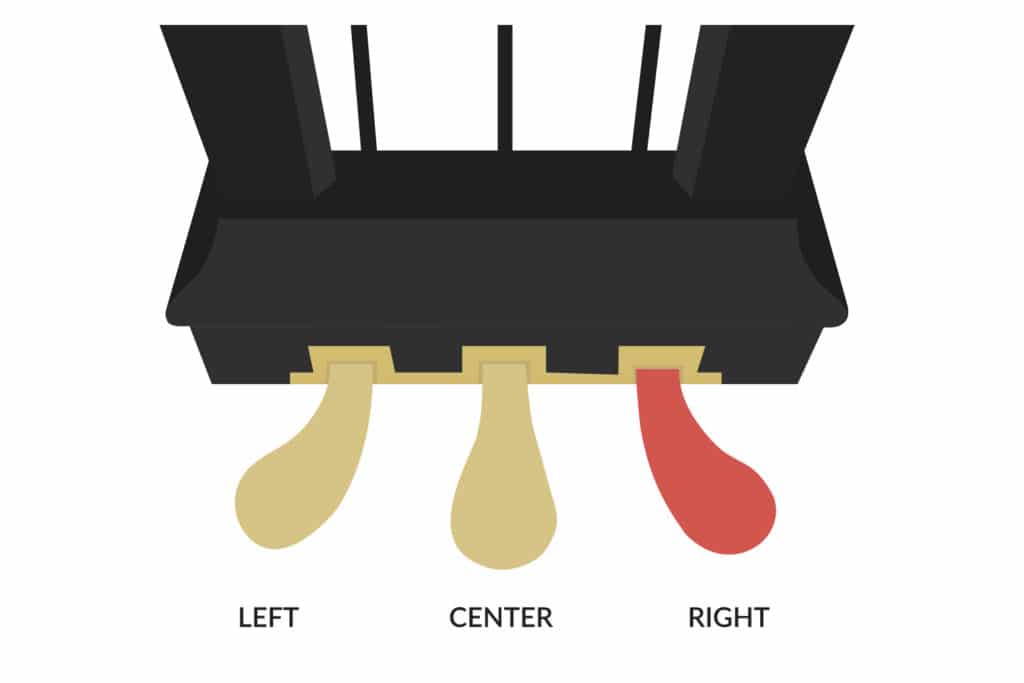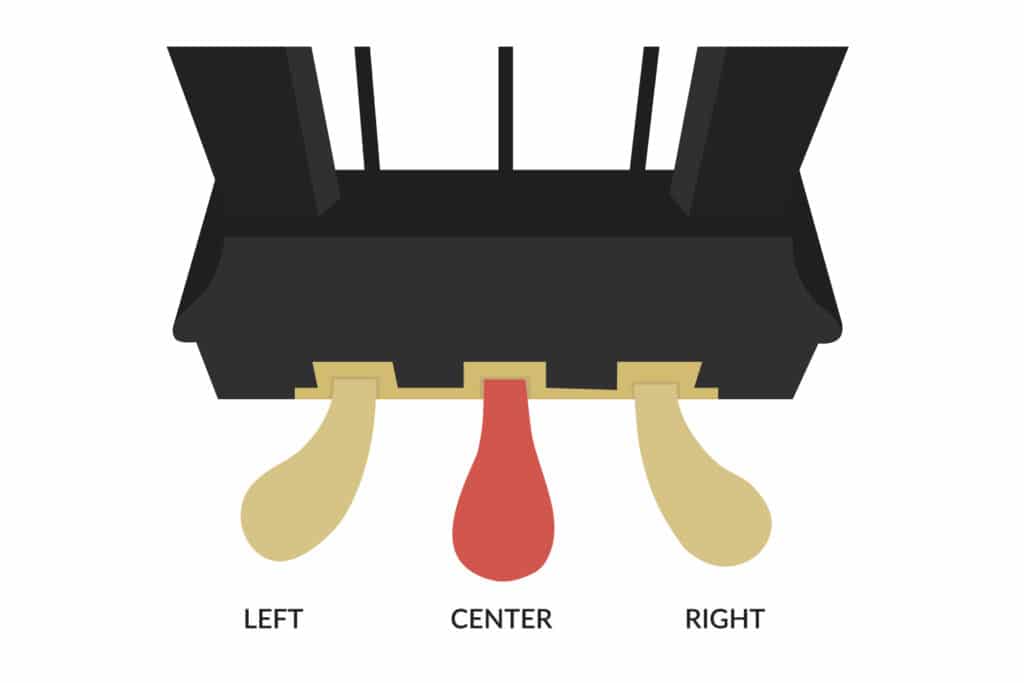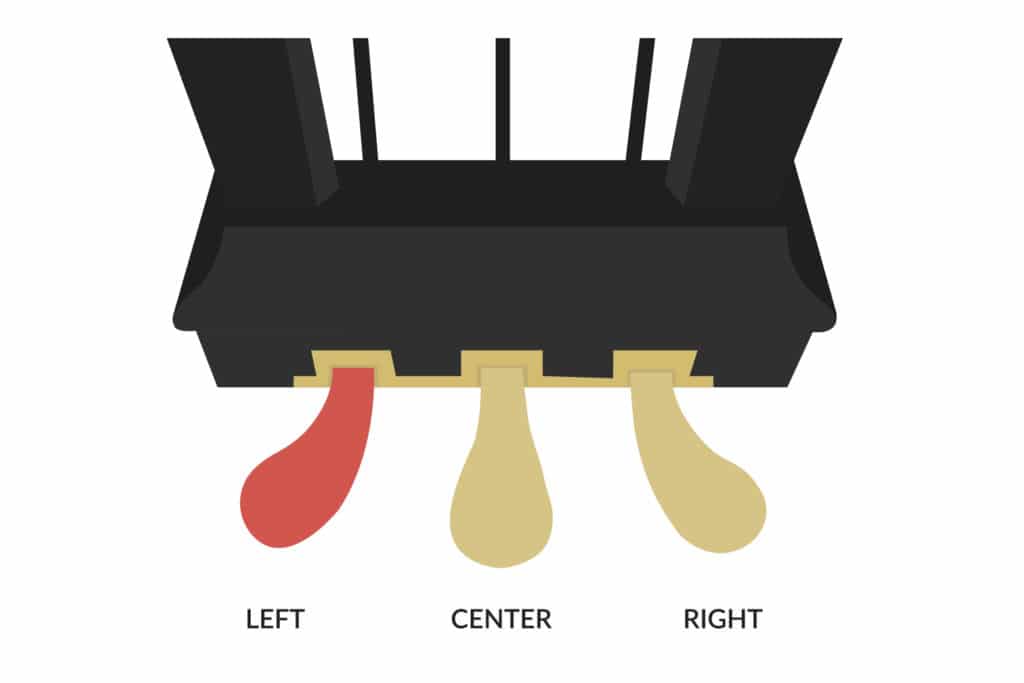Pianos are a mystery to those who are not musically inclined or beginners just learning to get the hang of it. People often think of a piano as a keyboard, with black and white keys in a straight line. What most people do not realize is that pianos also have pedals that are not visible from an observer’s point of view. They often wonder, what do the pedals on a piano do?
Beginners who do not anticipate dealing with an extra set of controls, like the pedals on a piano, often tend to panic when they see them. It is like learning to play the guitar and realizing there is a whole new component to it that you did not know of!
Well, it is not rocket science! We have compiled a guide to the pedals on a piano, which aims to explain the function of each of the pedals you see at the bottom inside of a piano. After reading our detailed guide, you will never have to wonder what the pedals on a piano do.
To help you get a better understanding, we will start with the basics of piano pedals.
Let’s acquaint ourselves with this mystery feature by establishing that there are a total of three pedals in a grand piano. These pedals have specialized names and functions.
These pedals function to tweak and alter the tone of the piano keys to be more compatible with the composition you are playing. These pedals are attached to the piano by the pedal support structure, which is an essential part of the piano frame.
These three pedals on a piano Trusted Source Piano pedals - Wikipedia Piano pedals are foot-operated levers at the base of a piano that change the instrument’s sound in various ways. Modern pianos usually have three pedals, from left to right, the soft pedal (or una corda), the sostenuto pedal, and the sustaining pedal (or damper pedal). Some pianos omit the sostenuto pedal or have a middle pedal with a different purpose such as a muting function also known as a silent piano. en.wikipedia.org operate a system consisting of levers and springs, which is professionally known as the Trapwork. When pianists use digital pianos, they find these features digitally incorporated, oftentimes for creating varying sounds, like that of an organ, to produce an acoustic piano effect.
The pedal-like features in a digital piano are added to serve more specific functions. Using these pedals can be tricky initially, but like any acquired skill, it becomes second nature with continued practice.
It is however important to start with the functions of each pedal, so let’s look at them in the following paragraphs.
 The rightmost pedal i.e., the damper pedal is the most frequently used one. It is also called the sustain pedal and it is extremely important for playing certain melodies.
The rightmost pedal i.e., the damper pedal is the most frequently used one. It is also called the sustain pedal and it is extremely important for playing certain melodies.
What it essentially does is lift all the dampers off the strings, sustaining the sound. The input features of this pedal are also present in a starters’ home keyboard, making it extremely important, especially for acoustic playing.
To get a clearer understanding of the functioning of the damper pedal, we need to unravel the mechanical workings of an acoustic piano. Pianos contain a number of strings that produce a ringing sound. This sound is produced when we press the piano keys, which causes the hammers inside the piano to hit the strings. The hammers retreat to their holding position once the keys are released, which ceases the ringing of the piano strings, thereby ending a note.
The damper comes into play to filter this process as it prevents the unplayed, resting piano strings from resonating when a played note is activated, keeping the resting springs deadened. A depressed damper pedal keeps the damper bar lifted, which enables other keys to resonate a played string, producing a continued ringing of a note even after the key has been released.
This is how it earns the name sustain pedal since it sustains a note for longer than the mechanism otherwise allows.
One causal effect of the damper pedal for an acoustic piano is that other untouched strings also resonate with the played strings, owing to the sympathetic vibrations it sends, creating a richer sound. This is the sympathetic resonance of acoustic pianos that most new digital pianos now mimic.
 The center pedal from the set of three pedals in a piano is perhaps the most perplexing, especially for beginners.
The center pedal from the set of three pedals in a piano is perhaps the most perplexing, especially for beginners.
The sostenuto pedal is quite similar to the damper, acting as a selective damper pedal. When you press the sostenuto pedal, the sostenuto rod is activated, which holds down only the dampers depressed by the played keys. This means that only the notes that you play, while engaging the middle pedal, will be sustained, without notes played after the pedal is released which do not resonate with the prior notes.
Moreover, the sustained notes will only echo till the sostenuto pedal is depressed, and as soon as you release it, the vibration ceases and the following keys that are played do not continue ringing belatedly.
This feature allows a selective resonation, which helps pianists to hold bass notes and chords as they play tunes, such as staccato melodies.
 The Una Corda is the leftmost pedal in the set. It is also called the soft pedal for its functioning. To understand the underlying functioning of the Una Corda pedal, we need to once again dissect the inner mechanism of an acoustic piano.
The Una Corda is the leftmost pedal in the set. It is also called the soft pedal for its functioning. To understand the underlying functioning of the Una Corda pedal, we need to once again dissect the inner mechanism of an acoustic piano.
Each note in an acoustic piano uses a grouping of three strings to produce its unique sound, which is tuned in such unison that creates a rich and rounded tone and produces a horrendous cacophony when out of tune. In an acoustic piano, a pressed key makes the hammer hit all three grouped strings at once. However, when the Una Corda is activated, the internal workings of the hammer shift toward the right, making the hammer hit only two of the three strings, which produces a softer note.
In older pianos, the Una Corda pedal worked such that the hammer only pressed down on only one rightmost string, which earned it the name Uno, as in one, and Corda, as in string. However, in newer and smaller models, less space inside the piano cabinets makes this mechanism more constrained, hitting two instead of one string. Therefore, the Una Corda pedal function in new pianos produces a different tone and volume.
If we consider more compact upright pianos, which have very less inner space, the Una Corda pedal is only able to produce a lower volume, however, the overall tone remains the same.
Now that you are well acquainted with the purpose and functioning of the three piano pedals, we can move on to the usage of these pedals. First and foremost is maintaining the correct posture and position, as it is with most musical instruments.
When using piano pedals, make sure that you sit at a distance, far enough from the piano, such that you have to extend and slightly stretch out your legs to reach and press the pedals. Sitting closely, with your knees bent will prove to be awkward and difficult to press the pedals.
Coming on to the frequency of usage, we understand that you can get hooked and even fixated on the soothing melody that the damper pedal produces. However, make sure not to overuse it. This is why it is also important to sit at a distance, so your foot doesn’t continuously rest on the pedal, making you press down unintentionally.
People who learn to play the piano on a digital piano or a keyboard are the least acquainted with the piano pedals and may feel amateur when it comes to pedal usage. They may even feel left out of the world of real pianists. However, this can be easily reprimanded.
Digital keyboards may not come with any pedals but most of them today come equipped with a standard three-pedal arrangement, which is similar to those of acoustic pianos. Digital pianos often have a ¼ inch input jack toward the rear, which is marked as the sustain jack. This feature enables you to have a close to authentic acoustic piano experience because it lets you connect a standalone sustain pedal to achieve the sympathetic resonance of a grand piano.
If you own a digital piano and wish to try out piano pedals, you can consider getting a standalone pedal. The Yamaha FC3A Piano-style Sustain Pedal with Half-damper Control is an excellent option that you can try!
Another great option according to popular reviews is the Roland RPU-3 Triple Pedal Unit with Half-Damper function, which offers a complete three-pedal experience with digital pianos! The only drawback of digital pianos is that you cannot get sostenuto and una corda pedal features in them.
Despite this drawback, there are several perks in digital pianos that you cannot enjoy in an old-school grand piano. You can try your hand at guitar and bass effects using a digital piano. Moreover, digital pianos and keyboards come with exciting pedal features of their own, including delay pedals, reverb pedals, octave pedals, fuzz, and overdrive!
If you are a beginner, who is looking for experiencing the amazing features of digital pianos, you can easily find some of the best sounding digital pianos and keyboards to start with!
For those of you who like digital pianos, but wish to try acoustic features as well, you can get some great weighted key digital pianos for acoustic playing.
As if this is not enough, you can also get a luxurious piano with a modern touch because now we have the option to buy the best digital grand pianos that are an amalgamation of class, elegance, and melody!
Now that you know all there is to know about piano pedals, you can flaunt your knowledge and educate your beginner pianist peers as well. We covered everything, from what piano pedals are and what pedals in a piano do, to how to use them.
The most commonly used one, in both old grand pianos and modern digital keyboards is the damper or sustain pedal. However, the other two are also unique in their own way. You can incorporate the usage of all three pedals in your piano sets by practicing every day until you master the art of using piano pedals like a pro!
We hope you found this guide useful and make the most of your piano playing adventures using piano pedals! Good luck and have fun!